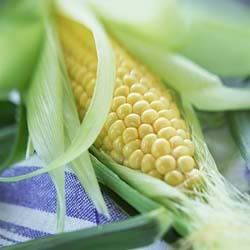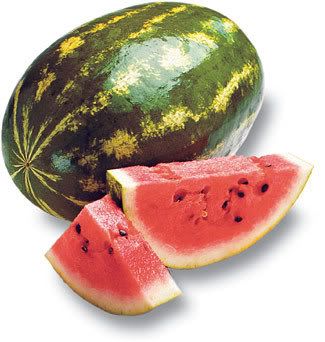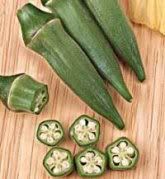CSA Week 14, Cycle B pick-upImportant CSA NewsThe CSA 2007 season ends on October 29th!
What's new this week? Corn
Corn is a versatile vegetable that is especially popular in Latin American cuisine. In addition to the kernels, the husks can be used for tamales, a popular Mexican dish in which various fillings, such as finely chopped meat, vegetables, and/or fruits are wrapped in a cooked cornmeal layer rolled up in the softened cornhusks.
The word corn can be traced to an Indoeuropean word that was translated to mean “small nugget,” while the Native Americans called the plant
mahiz.
Selection and Storage: Good quality white or yellow corn should have fresh green, tightly fitting husks, with golden brown silk, and tip ends that are free of decay. Ears should be evenly covered with plump, consistently sized kernels. Avoid corn that has been on display with husks pulled back, or with discolored or dry-looking husks, stem ends, or kernels.
It’s best to cook corn as soon as possible after it is picked or purchased. This is because, after being picked, the corn’s natural sugars gradually convert to starch, which, in turn, lessens the corn’s natural sweetness.
If you must store corn, use perforated plastic bags and get it into the refrigerator as soon as possible. Try to use the corn within 1 to 2 days and do not husk until just prior to cooking.
Preparation, uses, and tips: Fresh sweet corn must be cooked and is generally steamed or boiled and served as a side dish.
To boil, bring a large pot of water to bubble over high heat. Cook in batches, with husks and silks removed, adding a few ears at a time, so the water continues boiling. For fresh young corn, cook for 30 seconds—just long enough to heat the corn through; boil more mature corn for up to three minutes. Do not add salt to cooking water since that will toughen the corn.
To steam, remove husks, arrange corn on a steaming rack, and place the rack over about 1 inch (2.5cm) of water. Bring to a boil, cover, and steam for about 10 minutes.
Grilled corn on the cob is a summertime favorite. (The cob or the ear of the corn plant is actually a branch.) First, peel back the husks and remove the silk, then bring the husk back over the cob. Soak the corn ears in their husks in cold water for a few hours before grilling—this moisture will let the corn steam as it grills, making it juicier. To grill, wrap each ear of corn tightly in aluminum foil, place on a prepared preheated medium-hot grill, and cook for about 30 minutes, turning occasionally, until corn is tender. Serve hot off the grill, with butter or margarine, if desired.
You can also roast corn in the oven. Preheat oven to 350 degrees. Then simply place the corn (while it's still in its husk) directly on the oven rack and roast for 30 minutes. Peel back husks and enjoy.
Corn husks are used primarily in making tamales, but they are also used to wrap other foods for steaming.
Fresh corn kernels may be used as an ingredient in soups, stews, casseroles, puddings, relishes, and breads.
Sweet corn is high in fiber, niacin, folate and some vitamin A. Folate has been found to prevent neural-tube birth defects and current research suggests that it helps to reduce the risk of heart disease and stroke. Fiber, of course, helps to keep the intestinal track running smoothly.
Nutrition Facts (Serving size: 1 ear yellow sweet corn )
Calories 83.16
Protein 2.56 grams
Carbohydrates 19.3 grams
Dietary Fiber 2.15 grams
Potassium 191.73 mg
Vitamin A 167 IU
Niacin 1.24 mg
Folate 35.73 mcg
 Carnival Squash, one type of Winter Squash, pictured."Winter Squash"
Carnival Squash, one type of Winter Squash, pictured."Winter Squash" are hardy vegetables that are neither grown nor harvested in the winter, as the name seems to imply--they grow on frost-tender vines and are actually picked in the fall and stored until spring. Because of their hard, thick skins, they have the ability to keep through the cold winter months, a quality that made this member of the gourd family a staple vegetable before the days of modern shipping and freezing techniques. Under their hard skins, winter squash have large seeds and firm, deep-yellow or orange flesh.
The most common varieties of winter squash include acorn, buttercup, butternut, hubbard, pumpkin, spaghetti, and turban. Other varieties include calabaza, cushaw, delicata, golden nugget, kabocha, and vegetable marrow.
Buying and storing tips: Choose heavy squash with a smooth, hard, richly colored rind. Store winter squash for up to a week in a paper bag in the refrigerator, or in a cool, dry place for several weeks. Don’t store winter squash in plastic bags, because the plastic traps moisture and encourages spoilage and rot.
Preparation, uses, and tips: Wash the exterior of the squash just before using. Winter squash is best baked, but it can also be steamed or boiled. Cut butternut, acorn, or other winter squash in half lengthwise, scoop out and discard the seeds, and place squash halves, flesh-side-down, in a baking dish. Add 1/4-inch (0.6cm) of hot water, cover, and bake until tender. Scoop out flesh and purée with garlic, basil, and olive oil or butter. Winter squash can also be stuffed with seasoned bread cubes and seafood or cheese mixtures.
Nutritional Highlights: Winter squash, 1 squash (raw, acorn)
Calories: 172
Protein: 3.4g
Carbohydrate: 44.9g
Total Fat: 0.43g
Fiber: 6.46g
*Excellent source of: Magnesium (138mg), Potassium (1,495mg), Vitamin C (47mg), and Vitamin A (1,454 IU)
*Good source of: Calcium (142mg)
Much more info on all varieties of squash can be found
here.
RecipesSelected by Retu, unless otherwise noted.
Corn and tomato salad with cilantro dressingSubmitted by Rebecca, originally from
Bon Appetit - July 2006Makes 6 servings.
Combine in large bowl:
- 3 cups fresh corn kernels (cut from about 6 small ears of corn)
- 5 medium tomatoes, halved, seeded, chopped
- 2/3 cup finely chopped red onion
In blender, purée until smooth:
- 1/4 cup olive oil
- 1/4 cup chopped fresh cilantro
- 2 tablespoons chopped fresh mint
- 2 tablespoons white wine vinegar
- 1 tablespoon fresh lime juice
- 2 teaspoons (packed) golden brown sugar
- 1 garlic clove
- Salt and pepper
Just before serving, pour dressing over corn mixture and toss.
Everyday Chipotle Vegetable TamalesSelected by Olivia. From the
Post Punk Kitchen.
Makes 24-30 tamales.
This tamale recipe is as flexible as you want it to be; add roasted corn kernels, finely chopped chilies or scallions to the dough if you feel like it. I’ve kept the filling a basic bean, peppers and corn with essential addition of smoky chipotle chilies in spicy adobo sauce. Seasonal vegetables like zucchini, finely chopped steamed pumpkin, poblano chilies and even small bits of sautéed seitan would make perfect additions too.
Tamale Tips:
Canned chipotles in adobo sauce, corn husks and masa harina can be found in most large groceries with an “ethnic” section nowadays. Larger Latin American stores may have everything in stock too, as well as gourmet stores. Be sure to get masa harina mix (ground corn flour specially treated with lime water); don’t substitute with corn meal, it simply is not the same and will not work!
While preparing the dough and filling is simple enough I will not lie to you; tamale assembly can be tedious work. Don’t do it on 2 hours of sleep after pulling an all nighter, or an hour before that big date or before surgery. Enlist the help of a dear friend and promise them the warm, soul-embracing experience of eating adorably wrapped handmade tamales bursting with vegan love. Which means you’ll have to give them a few you greedy mustard.
Tamales freeze well after steaming, just wrap tightly in paper and pack in freezer bags.
If you can’t find dried corn husks for wrapping the tamales is, less attractive substitutes might be tinfoil or wax paper.
Dough:
4 Cups Masa Harina tamale flour
1/4 Cup olive or good quality corn oil
2 tsp. Baking powder
4 Cups vegetable broth, water or a combination of the two, warmed
Salt to taste (needed less if using all broth)
Chipotle bean filling:
2 Tablespoons Olive Oil
1 large onion, finely chopped
1 clove garlic, minced
1 red bell pepper, seeded and chopped small
1 small carrot, peeled and diced small
1 Cup frozen corn kernels
1 15oz. Can pinto or black beans, drained & rinsed
1/4 C veggie broth or water
2 chipotle peppers in adobo sauce, minced, plus 1-2 T of adobo sauce (from a 7oz can of chipotles in sauce)
3 Tablespoon tomato paste
1 tsp ground cumin
Salt to taste
Dried corn husks for wrapping tamales
First, place corn husks (you don’t need to separate them just now) in a pot large enough to cover completely with water. Cover with warm water and allow to soak for at least 20 minutes till husks are soft and pliable. Keep covered in water entire time as you use them.
In a large bowl combine masa harina, broth or water, salt, baking powder and oil. Stir to mix with a large spatula. If you have an electric mixer (hand or otherwise) now is the time to use it. Beat the mixture till it forms a dense, moist, fluffy dough and the side of the bowls are clean. If you don’t have a mixer beat it like hell with that spatula. Tamale dough steams up extra light and puffy when beat with an electric mixer but still tastes great when beat by hand. Cover bowl containing dough with plastic wrap or a damp towel and set aside.
In a large heavy bottom skillet heat olive oil over medium high heat. Add onions and garlic and sauté for 5 minutes. Add pepper and carrot and sauté for 3 minutes, then add beans, corn, broth, chipotles (the more chipotles and sauce the hotter) and adobo sauce, tomato paste and cumin. Sautee and simmer till most of liquid evaporates, about 8 minutes. Salt to taste and allow to cool before assembling tamales.
Depending the size of the corn husks you will need to use 1-2 husks per tamale. There are a billion ways to wrap a tamale: I like this way since it’s simple and makes super-cute traditional tamale shapes. Take corn husk and lay flat; spread about 2 T of dough about off-center, leaving about an inch and a half of space on the top and bottom. Spread a heaping tablespoon of filling on top, and on top of that dab about 1 T more of dough. Carefully roll up tamale, making sure to completely encase filling in corn husk. Tie both ends securely with either heavy duty kitchen string (maybe try different colors for different flavors), or simply tear a corn husk lenghth-wise into thin strips.
Prepare a large steamer basket and loosely pack tamales into it. Steam for 35-40 minutes. Tamales will expand and feel firm to the touch when done. Remove from heat and allow to cool slightly before serving (they will be really hot when unwrapped!). Serve with your favorite salsa, guacamole or make a whole affair out of it and serve with sides of rice and beans.
Creole Style Corn, Okra, and TomatoesSelected by Olivia. Adapted From
VeganCehf.com.
Serves 6-8
- 1 1/2 cups onion, diced
- 1 cup green pepper, destemmed, deseeded, and diced
- 1 cup red pepper, destemmed, deseeded, and diced
- 1 jalapeno pepper, destemmed, deseeded, and diced
- 2 Tbsp. olive oil
- 10 oz. sliced okra
- 2 T. garlic, minced
- 2 cups frozen corn, thawed
- 2 cups tomatoes, deseeded, and diced
- 1 8 oz. can tomato sauce
- 2-3 tsp. Creole Seasoning, to taste
- 1/2 tsp. salt
In a large non-stick skillet, saute the onion, green pepper, red pepper, and jalapeno in olive oil for 5 minutes or until softened. Add the okra and garlic, and continue to saute for 5 additional minutes. Add the remaining ingredients and stir well to combine. Cover, reduce the heat to low, and simmer for 20-25 minutes or until the vegetables are tender. Taste and adjust seasonings, if needed.
Basic Potato SaladServes 8
- Coarse salt and ground pepper
- 3 pounds potatoes scrubbed and cut into 3/4-inch cubes
- 1/3 cup white-wine vinegar
- 4 scallions, white part minced, green part thinly sliced
- 3/4 cup light mayonnaise
- Steam potatoes with salted water.
- Meanwhile, in a large bowl, combine vinegar, scallion whites, 1 teaspoon coarse salt, and teaspoon pepper.
- Add hot potatoes to vinegar mixture; toss to combine. Cool to room temperature, tossing occasionally, about 1 hour.
- Add mayonnaise and scallion greens to cooled potatoes; mix gently to combine. Serve, or cover and refrigerate up to 2 days.
Radish Coleslaw- 4 cups cabbage, shredded fine (I use green and red mixed)
- 1 cup carrots, shredded
- 10 radishes, shredded
- 1/2 cup sugar
- 1 teaspoon salt
- 1 tablespoon malt vinegar
- 1 cup mayonnaise
- Shred cabbage, sprinkle with sugar and salt.
- Let set for two hours or longer.
- Turn mixture over a couple of time while cabbage is leaching its juices.
- Drain liquid from bowl.
- Add rest of the ingredients, toss and serve.
- May be chilled and served the next day.
Radish Hot & Sour SoupServes 4-6
- 5 cups chicken stock
- 1/4 cup rice vinegar
- 2 T sugar
- 1/4 tsp. cayenne pepper
- 1/4 tsp. ground (dried) ginger
- 1 pound raw shrimp, peeled and deveined
- 6 oz. sliced radishes, about 1 1/2 cups
- 1 1/2 cups spinach leaves, shredded
- 2/3 cups thinly sliced green onions
In a large saucepan over medium heat, bring stock to a boil. Stir in vinegar, sugar, cayenne and ginger. Add shrimp and cook until shrimp turn pink and curl, about 3-4 minutes. Turn off heat, stir in radishes, spinach and green onions. Cover and let stand 2-3 minutes before serving.
Baked Stuffed Tomatoes- 4 large ripe tomatoes
- 1 can cream of mushroom soup
- Salt, pepper to taste
- Stuffing (see below)
- Buttered cracker crumbs
Stuffing:
- 1 onion
- 1/2 green pepper, chopped
- 1 rib celery, chopped
- 2 tablespoons margarine
- 2 to 3 cups bread crumbs or cooked rice
- chopped tomato centers
Cut slices from stem ends of tomatoes, scoop out centers. Chop and save centers for stuffing. Pour soup into a shallow baking dish; set tomatoes in soup. Sprinkle tomato cavities with salt and pepper. Stuff (stuffing directions below), sprinkle with buttered bread crumbs, and bake at 350° for about 30 minutes.
For Stuffing:
Cook chopped onion, green pepper, and celery in the margarine for 5 minutes, or until tender, stirring occasionally.
"Three Sisters" StewSelected by Olivia. From
In a Vegetarian Kitchen.
6 servings
In Native American mythology, squash, corn, and beans are known as of the "three sisters."
- 1 small sugar pumpkin or 1 large butternut or carnival squash (about 2 pounds)
- 1 tablespoon olive oil
- 1 medium onion, chopped
- 2 cloves garlic, minced
- 1/2 medium green or red bell pepper, cut into short, narrow strips
- 14- to 16-ounce can diced tomatoes, with liquid
- 2 cups cooked or canned pinto beans
- 2 cups corn kernels (from 2 large or 3 medium ears)
- 1 cup homemade or canned vegetable stock, or water
- 1 or 2 small fresh hot chiles, seeded and minced
- 1 teaspoon each: ground cumin, dried oregano
- Salt and freshly ground black pepper
- 3 to 4 tablespoons minced fresh cilantro
- Preheat the oven to 400 degrees.
- Cut the pumpkin or squash in half lengthwise and remove the seeds and fibers. Cover with aluminum foil and place the halves, cut side up, in a foil-lined shallow baking pan. Bake for 40 to 50 minutes, or until easily pierced with a knife but still firm (if using squash, prepare the same way). When cool enough to handle, scoop out the pulp, and cut into large dice. Set aside until needed.
- Heat the oil in a soup pot. Add the onion and sauté over medium-low heat until translucent. Add the garlic and continue to sauté until the onion is golden.
- Add the pumpkin and all the remaining ingredients except the last 2 and bring to a simmer. Simmer gently, covered, until all the vegetables are tender, about 20 to 25 minutes. Season to taste with salt and pepper.
- If time allows, let the stew stand for 1 to 2 hours before serving, then heat through as needed. Just before serving, stir in the cilantro. The stew should be thick and very moist but not soupy; add additional stock or water if needed. Serve in shallow bowls.




